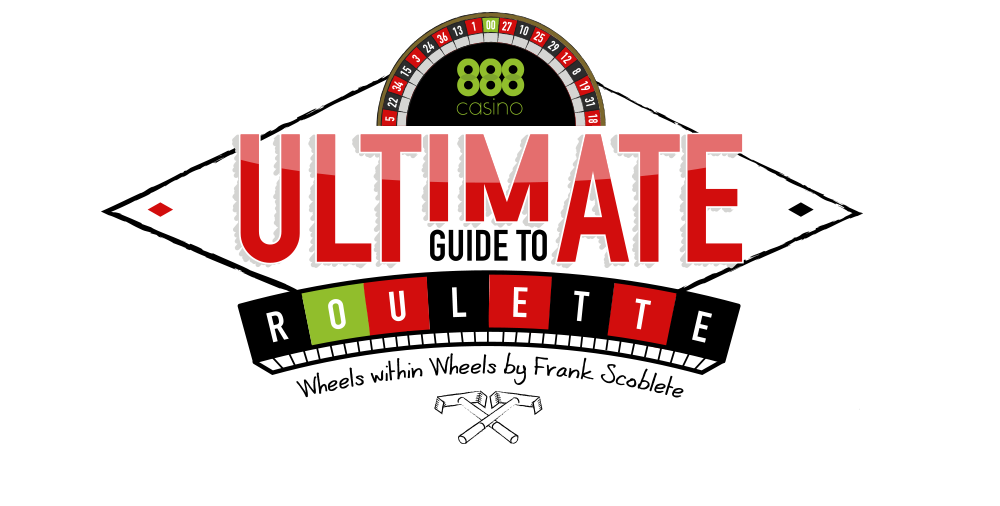

HOW TO PLAY ROULETTE

THE BASIC RULES WHEN PLAYING ROULETTE
- Roulette starts with players making bets.
- The croupier (or dealer) throws a ball into the spinning roulette wheel. Players can still makes bets within the process.
- While the ball is rolling at the roulette wheel, the croupier/dealer announces: "No more bets."
- At that point players are not allowed making bets
- The ball lands on a number in the roulette wheel. If there are winners who bet the number, section or color, they will be rewarded according of their betting odds.

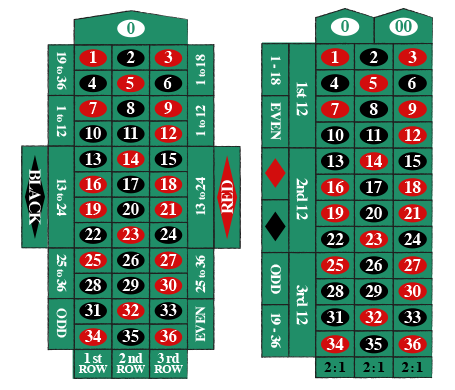
TYPES OF ROULETTE BETS
The players buy in for chips (or bring chips to the table), then place their bets on any number or propositions:- Inside bets are placed directly on one or more numbers
- Outside bets are placed on certain propositions such as high-low, odd-even, red-black, first, second and third dozen, etc.
- There are other combinations of bets that can also be made

ROULETTE BETS
Here are all the roulette bets and their edges
INSIDE BETS
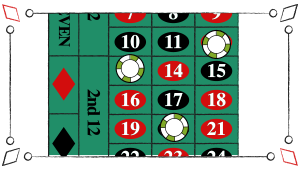
THE STRAIGHT UP
(French: En Plein)You bet one or more numbers by placing your bet on that or those numbers on the layout. If your number or one of your numbers should hit you win 35 to 1 on that number. The house edges: American double-zero wheel, 5.26 percent; the European single-zero wheel, 2.70 percent.

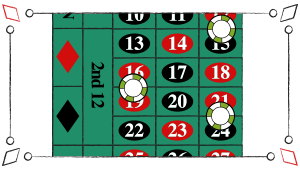
SPLIT BET
(French: A Cheval)This bet is placed on more than one number by placing your chip(s) on the line between two numbers. The payoff if either number hits is 17 to 1. The house edges are 5.26 for the American double-zero wheel and 2.70 for the single-zero European wheel.

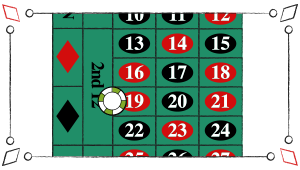
THE STREET BET, OR THREE NUMBER BET OR “SIDE BET” OR THE TRIO
(French: Transversal)You’d think with all these titles for the bet that it would pay off at thousands to one. Nope. It is merely a bet on three numbers. You make the bet by placing your chips on the outside border of the three numbers. A winning bet pays off at 11 to1. The house edge on the American double-zero wheel is 5.26 percent and it is 2.70 percent on the single-zero European wheel.

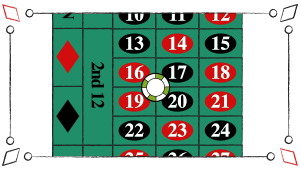
THE CORNER, THE SQUARE, THE FOUR NUMBER BET
(French: Carre)The bet is that one of four selected numbers will win. The bet can only be accepted if the four numbers form a square and, of course, being clever someone named the bet the Square. The bet is placed on the intersection where all four numbers meet. A winning bet pays 8 to 1. The house edge on the American double-zero wheels is 5.26% and it is 2.70% on the single-zero European wheels.

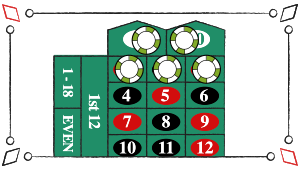
THE FIVE NUMBER BET
Also known as “The Monster” or “The Beast”This bet is only found on the American double-zero wheels. It incorporates five numbers: the 0, 00, 1, 2 and 3. A winning wager is paid at 6 to 1. The house edge (hold onto your heart) 7.89 percent! If you want to bet those five numbers you are better off just placing a chip or chips on each number and that will bring the house edge back down to 5.26 percent.

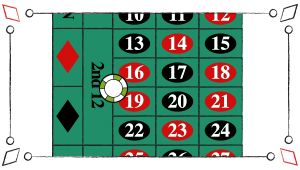
THE LINE BET, OR SIX NUMBER BET, OR SIXLINE BET
(French: Sixain)You place this bet on the outside borders of the six numbers you wish to bet on. The bet pays off at 5 to 1. The house edge on the American double-zero wheels is 5.26% and it is 2.70% on the single-zero European wheels.

OUTSIDE PROPOSITION BETS
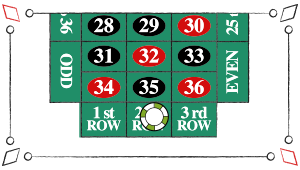
THE COLUMN BET
(French: Colonne)You are wagering that one of the columns of numbers on the layout will have the winning number. You place this number at the bottom of the column that you think will win. A winning bet is paid 2 to 1. The 0 or 00 are not a part of either column so if these two show the wager is lost. The house edge on the American double-zero wheels is 5.26 percent and 2.70 percent on the single-zero European wheels.

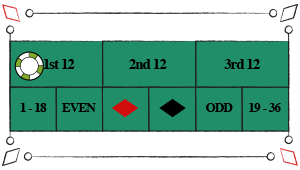
THE DOZENS BET
(French: Douzaine)The bet is whether one of a dozen numbers on the layout will hit. These are not a dozen consecutive numbers on the wheel; they are strictly layout numbers. You place this bet on First Dozen, Second Dozen or Third Dozen. You can bet two of the dozens. The payout is 2 to 1. Again the 0 and 00 will cause your bet to lose. The house edge on the American double-zero wheels is 5.26% and 2.70% on the single-zero European wheels.

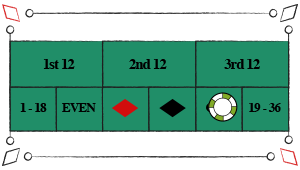
THE ODD OR EVEN BET
(French: Impair et Pair)To be placed on either the Odd or Even section of the layout. There are 18 odd numbers and 18 even numbers. Neither the 0 or 00 count for either bet and if one of them hits the house wins. The winning bet is paid even money which means one to one. The house edge on the American double-zero wheels is 5.26 percent and 2.70 percent on the single-zero European wheels.

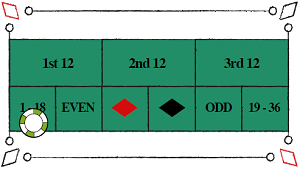
HIGH OR LOW BET
(French: Passe et Manque)This bet is placed on either the 1 to 18 or the 19 to 36 section of the layout. Once again if the 0 or 00 shows, the bet loses. Payoff is even money (one to one). The house edge on the American double-zero wheels is 5.26% and 2.70% on the single-zero European wheels.

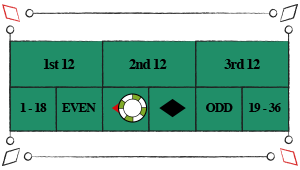
RED OR BLACK BET
(French: Rouge et Noir)This is another even-money bet that you can pick the color of the number that will hit. The house edge on the American double-zero wheels is 5.26 percent and 2.70 percent on the single-zero European wheel.

ROULETTE RULES
Playing roulette looks easy; pick a number or some proposition such as red/black, bet it and then wait to see what happens. That is, of course, the essence of the game. But it is not actually how the game is played.
Roulette has rules about the following:
- How to get chips
- How to determine value of the chips
- When to bet
- How to bet that bet or those bets
- When you must stop betting
- How to determine value of the chips
- When to bet
- How to bet that bet or those bets
- When you must stop betting
- how to handle other
players at your table
- What happens if you win
- What happens if you lose
- When to start betting all over again
players at your table
- What happens if you win
- What happens if you lose
- When to start betting all over again


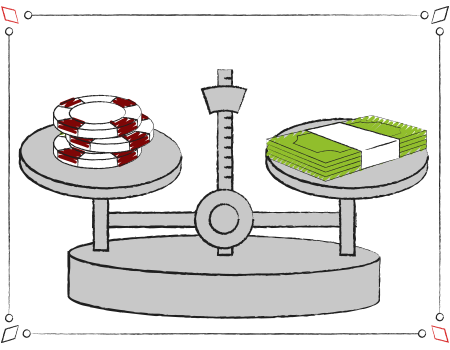
RULE #1: GETTING THOSE ROULETTE CHIPS
In many casinos the roulette chips are not the same as the chips used at the other table games (although those regular chips can be used at roulette). The roulette chips can be quite colorful.In some European casinos the roulette chips are indeed the same as chips at other games and (boy! oh! boy!) the dealers better be sharp not to mix up the various players’ bets.
So you arrive at the table, take out your money and put it on the table when the game is between decisions. You tell the dealer how much each of your roulette chips will be worth, she indicates that amount on her “wheel” of chips, and then she parcels your chips out to you.
They now have the value you want them to have.

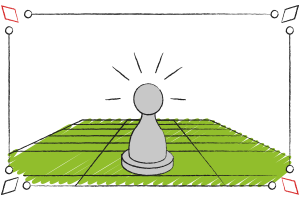
RULE #2: WHEN TO BET
After you cash in you will notice that there is a “buck” or “puck” or small symbolled object sitting on the table. That object indicates which number was hit on the last decision. When the dealer removes it the betting begins.Usually players make their own bets but the dealers will help players who can’t reach far enough to place the bet they want.

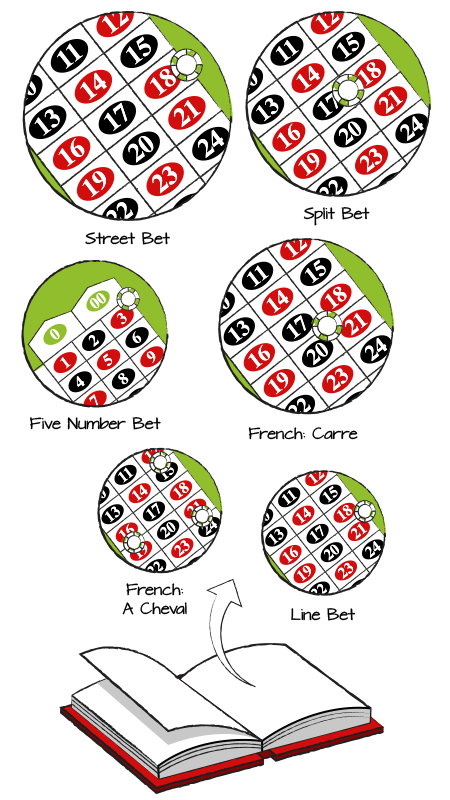
RULE #3: HOW TO BET THAT BET OR THOSE BETS
If you are betting straight up on the number(s) you just put your chip(s) on the number(s). If you are betting any of the proposition bets on the outside of the layout such as the even-money bets of red/black (French: Rouge et Noir), odd/even (French: Impair et Pair), high/low (French: Passe et Manque) you place these right on the proposition. These all pay 1-to-1.The first, second or third dozen (French: Douzaine); the first, second or third column (French: Colonne), you will again place your wager exactly on the proposition. These bets pay 2-to-1.
Now here are some other bets and where you place them and how much they pay on a win:
Split Bet (French: A Cheval): If you want to bet two numbers next to each other place your chip(s) on the line between the two numbers. The win is 17 units per 1 unit wagered.
The Street Bet, or Three Number Bet or “Side Bet” or The Trio (French: Transversal): If you wish to bet on three numbers, place your wager on the outside border of the three numbers. A win pays off at 11 to1.
The Corner, the Square, the Four Number Bet (French: Carre): After three numbers comes? Yes, of course, four numbers! The numbers much form a square. Place the bet where at the intersection where all four numbers meet. A win pays 8 to 1.
The Five Number Bet: This bet (the worst of all roulette bets because it has the highest house edge of 7.89%) is place on the 0, 00, 1, 2 and 3. A win pays 6 to 1. This bet is also known as the “beast” or the “monster” or the “mother-in-law.”
The Line Bet, or Six Number Bet, or Sixline Bet (French: Sixain): Split Bet
(French: A Cheval): This wager is placed on the outside borders of six numbers. A win pays 5 to 1.

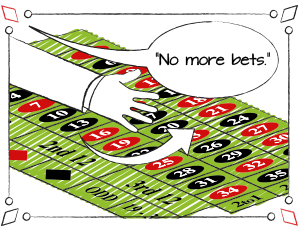
RULE #4: WHEN YOU MUST STOP BETTING
The dealer will spin the wheel, even as bets are being made, but at a certain point he will wave his hand over the layout and say, “No more bets.” From that point on (okay, guess) no more bets are to be placed.Now some players, known as PITA’s (for pain-in-the as*es) will keep betting. At that point the dealer can disqualify those bets.

RULE #5: HOW TO HANDLE OTHER PLAYERS AT YOUR TABLE
Most roulette players are nice people, as are no doubt you. But some of them are somewhat (how can I say this gently?) apelike. Since everyone places their own bets, and since multiple bets can be places on the same number or proposition, the apes have a tendency to push and shove other players to get their bets down. They will even knock over piles of chips – other players’ chips.There is, of course, no need for such aggressive activities as dealers give roulette players plenty of time to make their bets.
You have three choices:
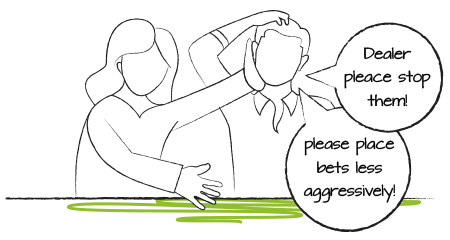
1. Ask the ape-man or ape-woman to please place his/her bets somewhat less aggressively because he/she has been knocking over chips and sometimes people. Chances are the ape-thing will just growl and continue on its way.
2. Tell the dealer to stop them. “Dealer, dealer, this creature over here is a beast and keeps bumping other players and knocking over chips.” The dealer might say something to them and maybe it will work.
3. Or, get up and go to another table.

RULE #6: WHAT HAPPENS IF YOU WIN
When a number hits, the dealer will call out the number, (perhaps also the color, and whether it is odd or even, etc.). She will put the “puck” on the number and sweep the board of all the losing bets.She will then pay the winning bets.

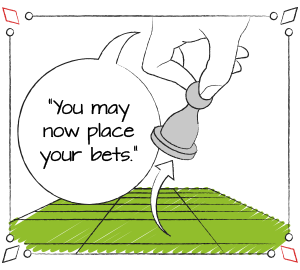
RULE #7: WHEN TO START BETTING ALL OVER AGAIN
While the “puck” is in place on the winning wager, no betting can take place. When the winners are paid, the dealer will remove the puck and he’ll say something such as “You may now place your bets.” At this time you take your next shot at corralling Lady Luck.If you follow these general rules you should enjoy your roulette experience. it's fun to play roulette and people have played it for centuries. If you have never played roulette before why not give it a try? I think you’ll find it an exciting game. But again, follow the rules!

KEY ELEMENTS
- The organization of numbers on the American and European wheels is different.
- There are 37 numbers on the single-zero wheel and 38 numbers on the double-zero wheel.
- The house edges on the single-zero wheel are smaller than the house edges on the double-zero wheel.
- On the American double-zero wheels, the house edge can go from 2.63 percent to 7.89 percent. The usual house edge on the American game is 5.26 percent.
- On the European single-zero wheels the house edge can go from 1.35 percent to 2.70 percent. The usual house edge on the European game is 2.70 percent.
- You can easily see that the European game is quite superior to the American game.

ROULETTE HOUSE EDGES
Like craps, roulette has a multitude of bets which I’ll discuss shortly. However the range of the house edges on roulette bets is not as great or as varied as the range in craps. On the American double-zero wheels, the house edge can go from 2.63 percent to 7.89 percent. The usual house edge on the American game is 5.26 percent.On the European single-zero wheels the house edge can go from 1.35 percent to 2.70 percent. The usual house edge on the European game is 2.70 percent. You can easily see that the European game is quite superior to the American game.

HOW TO FIGURE THE ROULETTE HOUSE EDGE
The American wheel has 38 numbers and the payment for a winning bet is 35 to 1. In a fair game, one where the casino does not have the edge, the payout for the winning bet should be 37 to 1. In short, you bet 1 and you win 37. So you will lose 37 times but win once and the game is even; there is no edge for either the player or the casino. That is zero percent.Casinos cannot make a profit on such a game, so they pay back less than the bet is worth, 35 units instead of 37 units. It keeps two units for itself. Just divide 2 into 38 and then multiplay the result by 100 and the house edge is 5.26%. (I will discuss the other house edges when I deal with the specific bets that come in with more or less than a 5.26% edge.) This 5.26% is the house edge on the inside numbers and the outside propositions such as red-black, odd-even and so forth.
The European roulette game as stated is better than the American roulette game, because of that single 0. There are 37 numbers and the casino pays back 35 to 1 for a winning bet. The casino is keeping “1” as opposed to the American casinos keeping “2.” Just divide 1into 37 and the house edge is 2.70%. (I will later explain the other bets that come in with a lower house edge than 2.70%.)
[Please note: The ball is spun one way around the ball track but the wheel is spinning the opposite way. These directions can be changed intermittently or after every spin.]


PLAYING ROULETTE

BUYING INTO THE GAME
Many American casinos have special roulette chips of various colors for denominations that you don’t usually see in the rest of the casino. The player determines what his colored chips are worth and each player must have a distinct color.In Europe this is usually not so and the typical casino chips will be the same at the roulette game. This can, at times, cause some confusion for the croupiers which might make players call them “horse’s asses.”
“NO MORE BETS”
Now the croupier will indicate that players can make their bets and the bets are placed on the layout. At a certain point the croupier says, “No more bets” and all players must stop betting – except for the annoying players who just keep on betting.Should someone place a bet after the dealer says, “No more bets,” the player’s hand is chopped off, leaving a bloody mess on the layout. (Sorry, no, the bet just doesn’t count.) The croupier usually calls “no more bets” after he has started the ball spinning in the groove that goes around and around the top of the wheel.
THE ROULETTE SCOREBOARDS
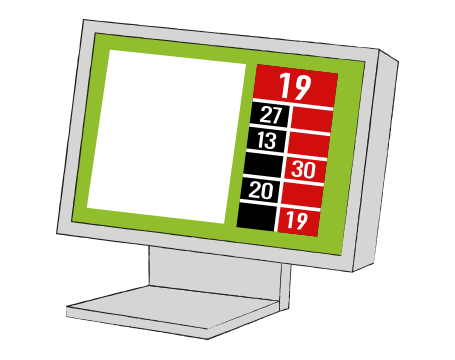
It is now common to see a scoreboard that highlights which numbers have just been selected, usually the last 16 or 20. This allows trend bettors to figure out what trends they want to bet.
There are now also scoreboards that can tell you which numbers have come up on all the live roulette tables being used in the casino!

THE STRUCTURE OF ROULETTE: THE WHEELS
The layout of the roulette wheel has nothing to do with the organization of the numbers on the wheels. Check out the previously pictured roulette wheels and you will see that the numbers are well spread out and not in numerical order. The players are generally interested in placing their bets on the layout (check layout design) without regard to how the numbers appear on the wheel, something of a mistake on their part as you shall see later on.The casinos of the past knew that some wheels through age and use could form a bias, meaning certain pockets would tend to latch onto a ball more than other pockets (these were usually deeper pockets), or that the wheel could become slightly unbalanced allowing a certain section to hit more than other sections.
If players concentrated on the layout as opposed to the wheel’s design then all would be well with the world and the casino would continue to win – except that some players caught on and discovered they could read the wheels. Such players were able to “break the banks” of casinos!
Let’s take a look at the spacing of numbers first on the American double-zero wheels, and then on the European single-zero wheels.

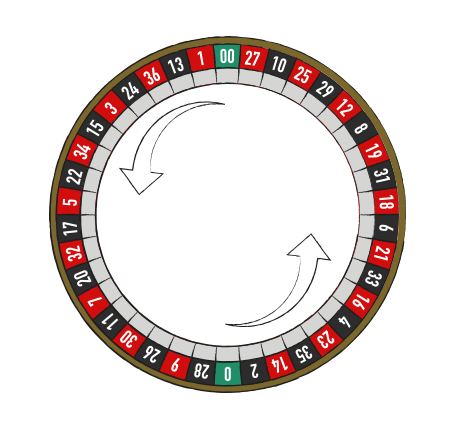
THE NUMBER SEQUENCE ON THE AMERICAN WHEEL
- There are 38 numbered pockets for the ball to land in, 1-36 and 0, 00.
- Half the numbers are red; half are black and the 0 and 00 are usually green, although on some wheels these might be blue.
- You can see that directly (or almost directly) across from each even number is an odd number. Check out 34 and you will see that it is almost directly across from 33. Then look at 36 and it is across from 35.
- This is not, however, a perfect design since the numbers 18 and 19 are only separated by the number 33.
- Pairs of odd numbers alternate with pairs of even numbers except in the areas of the 0, which splits 2 and 28, and 00 which splits 27 and 1.
- The colors of the numbers match the color of the numbers on the layout. The colors only deal with one bet, the black or red.
THE NUMBER SEQUENCE ON THE FRENCH OR EUROPEAN WHEEL
- There are 37 numbered pockets for the ball to land in, 1-36 and 0.
- Half the numbers are red; half are black and the 0 is either green or blue.
- Some of the positions of the numbers are similar to the American wheel with an odd number being directly across from an even number such as 27 across from 28 but this does not prevail throughout the wheel.
- The colors of the numbers match the colors on the layout; again this is used for one bet, the red and black.
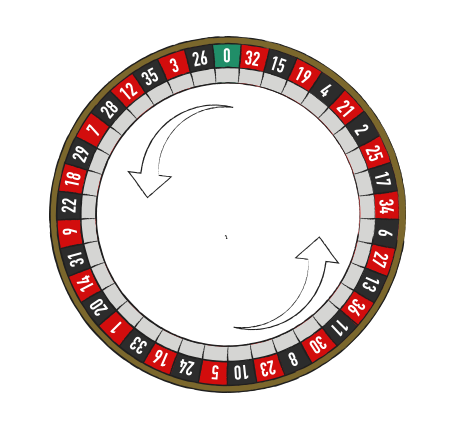

KEY ELEMENTS
- The layout where players make their wagers is not the same as the distribution of the numbers on the actual wheels.
- The layout is done in numerical order; the wheel is done by splitting up the numerical order.
- Inside bets are placed directly on one or more numbers.
- Outside bets are placed on certain propositions such as high-low, odd-even, red-black, first, second and third dozen, etc.
- The organization of numbers on the American and European wheels is different.
- There are 37 numbers on the single-zero wheel and 38 numbers on the double-zero wheel.
- The house edges on the single-zero wheel are smaller than the house edges on the double-zero wheel.
- On the American double-zero wheels, the house edge can go from 2.63 percent to 7.89 percent. The usual house edge on the American game is 5.26 percent.
- On the European single-zero wheels the house edge can go from 1.35 percent to 2.70 percent. The usual house edge on the European game is 2.70 percent.
